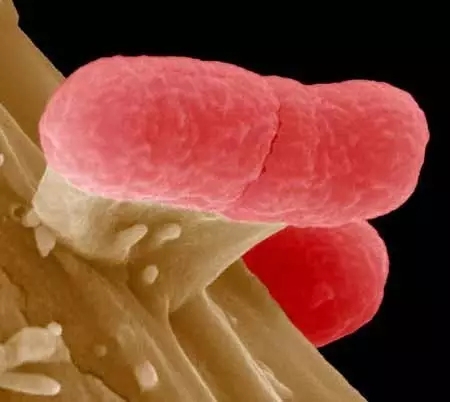5问产志贺毒素大肠埃希菌,谨防食物中毒!2016-06-16 SIFIC热点团队 SIFIC官微
编者按 首先恭贺中华预防医学会第25 次全国医院感染学术年会暨第12 届上海国际医院感染控制论坛(SIFIC)联合会议在苏州顺利召开。今年的大会主题为“培养微生物思维、倡导精准化感控”。众所周知,微生物广泛存在于我们体内外环境中,每天我们从饮食中可能“吃入”不少微生物。那么,哪些是无害的,哪些是有害的呢?我们又如何预防相关感染的发生呢?本文将对体内外广泛存在的一类菌群-大肠埃希菌进行阐述。
产志贺毒素大肠埃希菌与食品安全
Shiga Toxin-Producing E. coli & Food Safety
检索:李元叶 翻译:李元叶 济宁市第一人民医院 樊虹雨 山西省太原市山西医科大学 审核:高珊 河南省郑州市郑州大学第一附属医院 陈志锦 广东医科大学附属东莞市厚街医
尽管大多数的大肠埃希菌是无害的,但是有些也能致病。了解大肠埃希菌相关知识,可以帮助我们减少感染的发生。

什么是大肠埃希菌大肠埃希菌是存在于环境、食物以及人和动物肠道的一类细菌。 大多数大肠埃希菌是无害的,并且是健康人体肠道菌群的重要组成部分。然而,一些大肠埃希菌可以导致腹泻、尿路感染、呼吸系统疾病、血流感染以及其他疾病。这些致病的大肠埃希菌可通过污染的水或食物、以及与动物或者人的接触而传播。
什么是产志贺毒素大肠埃希菌它是一类通过产生志贺毒素而致病的大肠埃希菌,所以将可产生这类毒素的细菌称为产志贺毒素大肠埃希菌,或简称STEC。产志贺毒素大肠埃希菌主要有两种亚型构成:O157型和和非O157型。
哪些人会发生产志贺毒素大肠埃希菌感染所有年龄段的人群均可发生感染。虽然年幼的儿童比其他人更容易发生严重感染以及并发溶血性尿毒症综合征,但即使是年龄较大的健康儿童和成人也可发生严重感染。

产志贺毒素大肠埃希菌感染有哪些症状产志贺毒素大肠埃希菌感染后的症状表现因人而异,多见严重的胃痉挛、腹泻(通常为血性)和呕吐。如果出现发热,体温通常不会很高(低于38.33℃)。多数患者病情在5-7天内好转。一些感染症状是很轻微的,但有时也会很非常严重甚至危及生命。 大约有5-10%的O157大肠埃希菌感染者会发生潜在致命并发症,即溶血性尿毒症综合征(HUS)。其主要表现包括,排尿次数减少,疲乏,面颊和下眼睑内苍白。并发HUS后,肾脏可能会停止工作并产生其他严重的问题,患者应住院治疗。多数合并HUS的患者会在几周内治愈,但有些会产生永久性损害甚至死亡。 联系你的医生 如果出现持续腹泻超过3天;腹泻伴有高热,便中带血;或大量呕吐以至于无法正常进水并且尿量极少这些症状时,你应该与医生联系。
如何预防产志贺毒素大肠埃希菌感染了解食物中毒的风险 食源性疾病传播的高风险人群包括:孕期妇女、新生儿、儿童、老人和免疫力低下人群。 适时践行卫生措施,尤其是良好的洗手习惯 1. 如厕、换尿布后,准备食物和用餐前彻底清洁双手。 2. 与动物或者其生活环境(如农场、动物园、赛会、甚至是自家的后院)接触后彻底清洁双手。 3. 为婴幼儿准备喂养奶瓶或食物前,在接触婴幼儿的口腔前,接触安慰奶嘴或其他进入婴幼儿口腔中的物品前彻底清洁双手。 4. 保持进入婴幼儿口腔中所有物品的清洁(如安抚奶嘴和出牙嚼器)。 5. 如果没有肥皂和水,可以选择含酒精的手消毒剂。在一些情况下,这些产品可以快速消减手部细菌,但并不能完全替代肥皂和流动水清洁双手。 遵循清洗、单独放置、烹调和冷藏的指南,详细内容参考FoodSafety.gov网站. 将肉做熟 在牛排和烤肉(包括已经使用机器/针串嫩化的)烹饪时最低内部温度不少于62.6˚C(145°F),为了食品安全和质量,做好后应放置至少3分钟再食用。已绞碎的牛肉产品烹饪时最低内部温度不少于70˚C(160°F)。建议使用食物温度计进行温度核实,因为通过肉的颜色来判断并不可靠。 预防食物准备区域的交叉感染 双手、台面、案板和餐具在接触生肉后应充分清洗。 避免食用生牛奶、未经高温消毒的奶制品和果汁类(如新鲜的苹果汁)。 避免误吞游泳池水 在湖边、池塘、溪流、游泳池和自家儿童泳池中玩耍时,避免误吞泳池水。
英文原文
Although most kinds of E. coli are harmless, others can make you sick. Learn about E. coli and what you can do to help lower the risk of infection.
What are Escherichia coli? Escherichia coli (abbreviated as E. coli) are bacteria found in the environment, foods, and intestines of people and animals. Most E. coli are harmless and actually are an important part of a healthy human intestinal tract. However, some E. coli can cause diarrhea, urinary tract infections, respiratory illness, bloodstream infections, and other illnesses. The types of E. coli that can cause illness can be transmitted through contaminated water or food, or through contact with animals or people. What are Shiga toxin-producing E. coli? One particular type of E. coli causes disease by making a toxin called Shiga toxin. The bacteria that make these toxins are called "Shiga toxin-producing E. coli," or STEC, for short. STEC is often sub-divided into two categories: E.coli O157 and non-O157 STECs. Most common type of STEC: The most commonly identified STEC infections in North America are E. coli O157:H7 (often shortened to E. coli O157 or even just O157). When you hear news reports about outbreaks of E. coli infections, they are usually talking aboutE. coli O157. Other types of STEC: Other types of E. coli in the STEC pathotype are sometimes called "non-O157 STECs."
Who gets STEC infections? People of any age can become infected. Very young children are more likely than others to develop severe illness and a complication called hemolytic uremic syndrome, but even healthy older children and adults can become seriously ill.
What are the symptoms of STEC infections? The symptoms of STEC infections vary for each person but often include severe stomach cramps, diarrhea (often bloody), and vomiting. If there is fever, it usually is not very high (less than 101˚F). Most people get better within 5–7 days. Some infections are very mild, but others are severe or even life-threatening. Around 5–10% of those who are diagnosed with E. coli O157 infection develop a potentially life-threatening complication known as hemolytic uremic syndrome (HUS). Clues that a person is developing HUS include decreased frequency of urination, feeling very tired, and losing pink color in cheeks and inside the lower eyelids. Persons with HUS should be hospitalized because their kidneys may stop working and they may develop other serious problems. Most persons with HUS recover within a few weeks, but some suffer permanent damage or die. Contact your healthcare provider if you have diarrhea that lasts for more than 3 days, or is accompanied by high fever, blood in the stool, or so much vomiting that you cannot keep liquids down and you pass very little urine.
How can STEC infections be prevented? Know your risk of food poisoning. People at higher risk for foodborne illness are pregnant women, newborns, children, older adults, and those with weak immune systems. Practice proper hygiene, especially good hand washing.
Wash your hands thoroughly after using the bathroom, changing diapers, and before preparing or eating food. Wash your hands thoroughly after contact with animals or their environments (at farms, petting zoos, fairs, even your own backyard). Wash your hands thoroughly before preparing and feeding bottles or foods to an infant or toddler, before touching an infant or toddler's mouth, and before touching pacifiers or other things that go into an infant or toddler's mouth. Keep all objects that enter infants' and toddlers' mouths (such as pacifiers and teethers) clean. If soap and water aren't available, use an alcohol-based hand sanitizer. These alcohol-based products can quickly reduce the number of germs on hands in some situations, but they are not a substitute for washing with soap and running water.
Follow clean, separate, cook, chill guidelines, which can be found at FoodSafety.gov. Cook meats thoroughly. Beef steaks and roasts (including those that have been mechanical/needle tenderized) should be cooked to a minimum internal temperature of 145°F (62.6˚C) and allowed to rest for at least 3 minutes for safety and quality. Ground beef products should be cooked to a minimum internal temperature of 160°F (70˚C). Always use a food thermometer to verify the temperature because the color of meat is not a reliable indicator that the meat has been cooked to the safe internal temperature. Prevent cross-contamination in food preparation areas by thoroughly washing hands, counters, cutting boards, and utensils after they touch raw meat. Avoid consuming raw milk, unpasteurized dairy products, and unpasteurized juices(such as fresh apple cider). Avoid swallowing water when swimming and when playing in lakes, ponds, streams, swimming pools, and backyard "kiddie" pool
[本文图片来源于互联网,如有侵权请告知] 图文编辑:宋小船 审稿:高晓东 马嘉睿
|  /1
/1 